“A website without the conversion rate optimization is like a car without wheels – it will go you nowhere“
— Jeremy Abel, chief strategist at rDialogue
Driving tons of traffic to your website but not getting the desired results? It’s time to start thinking about the actual business growth engine, Conversion Rate Optimization (CRO).
Optimizing websites to convert visitors into paying customers is the most valuable skill businesses must learn in the digital age. Even minor improvements to a website’s ability to convert visitors into customers can translate into enormous revenue and growth gains.
However, many businesses fail to prioritize CRO, missing out on quick wins requiring no extra advertising or traffic acquisition spending. So, where do you start? What should you optimize? And how do you know your changes are working? We will walk through a step-by-step framework for planning, executing, and optimizing highly effective website conversion rate optimization strategies.
We will discuss:
Whether entirely new to CRO or looking to improve current efforts, these actionable insights will boost conversions, lower acquisition costs, and unlock growth. Let’s dive in!
Conversion rate is defined as the percentage of website visitors that complete a desired action. It measures how effectively the website turns visitors into customers or leads.
A high conversion rate indicates the website is optimized to guide users toward completing key actions like purchases, downloads, signups, etc. On the other hand, a low conversion rate suggests the website needs improvement in the customer journey.
First, define critical goals, including purchases, downloads, newsletter signups, contacting sales, etc. Afterward, calculate the conversion rate by dividing the number of conversions by the total number of visitors to the website in a given time and multiplying the result by 100 to get a percentage.
For example, if you had 200 conversions and 4000 visitors in a month, the conversion rate would be (200 / 4000) x 100 = 5% conversion rate.
Here are more examples from Wall Street Prep:
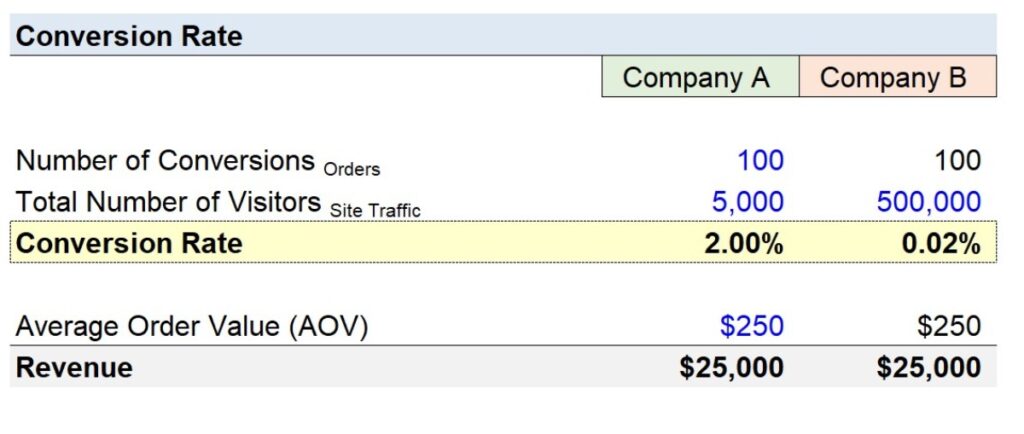
Image source is Wall Street Prep
The timeframe used to calculate the conversion rate can be daily, weekly, monthly, or other durations.
There are numerous online tools available for calculating the conversion rate such as WebFX, Gigacalculator and others:
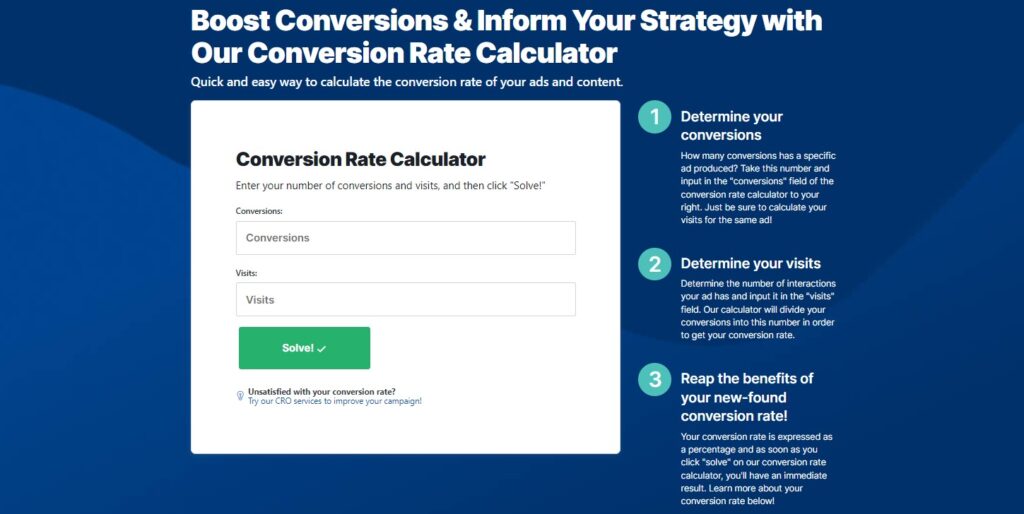
Webfx conversion rate calculator
The ideal conversion rate will vary significantly depending on the industry, business model, and goals. Rather than focusing on arbitrary targets, build a conversion rate optimization roadmap tailored to your website.
Focus on continuously testing and improving specific pages and processes to increase conversions. However, the following average conversion rates can provide general guidance on what’s typically achievable:
However, don’t get fixated on industry averages. While industry averages provide context, conversion rate optimization priorities are ultimately driven by business goals and customer journey data. Analyze your analytics reports to establish a baseline conversion rate across key funnels. Defining the starting point enables measuring optimization impact in the future.
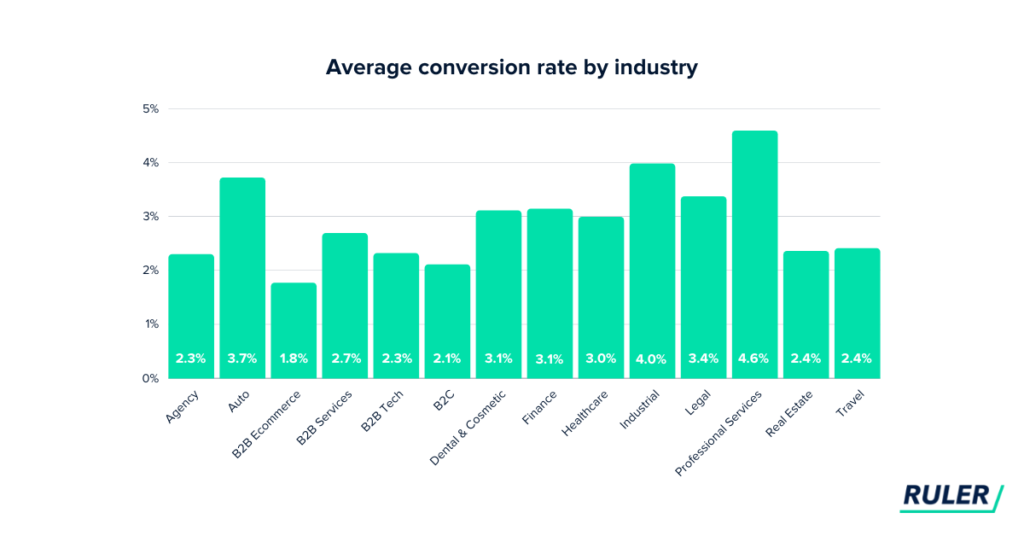
Ruler Analytics statistics
Implementing accurate conversion rate tracking is crucial for monitoring the impact of your optimization efforts. Follow these best practices:
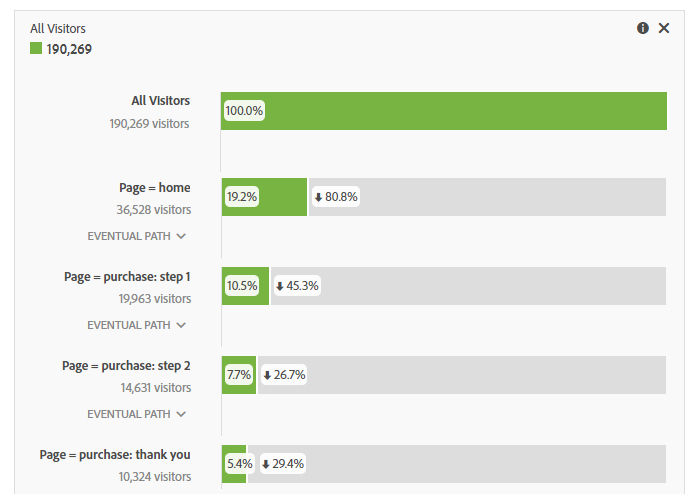
Fallout report provided by Experience League-Adobe
“It’s much easier to double your business by doubling your conversion rate than by doubling your traffic.”
– Jeff Eisenberg, President, and CEO of EVR Advertising
Conversion rate optimization (CRO) is the strategic process of increasing the percentage of website visitors who complete the desired goals. It uses customer data, testing, and analysis to systematically remove friction and optimize the user experience to boost conversions.
The main goal of CRO is to help more visitors complete key actions that provide business value, such as:
By removing hurdles in the user journey, CRO makes converting visitors easier, leading to higher sales, lower acquisition costs, and faster growth.
Implementing an effective CRO strategy delivers tangible business benefits that directly impact key financial metrics and KPIs. However, what exactly are those benefits? And why should you prioritize CRO?
Hence, making conversion rate optimization a core focus will directly impact top and bottom-line business results.
With an entire website to optimize, it is essential to identify key pages and conversion funnels to focus CRO efforts where they will have the most significant business impact.
For e-commerce sites, the primary goal is driving online sales through the website funnel. Therefore, heavily prioritize optimizing each step in the purchase process:
“When you focus on benefits with plain and simple copy, people end up converting because of how easy it is to understand what your product can do for them. Simple copy converts better—and also tends to be much harder to write.”
Hiten Shah, Co-Founder and CEO of FYI
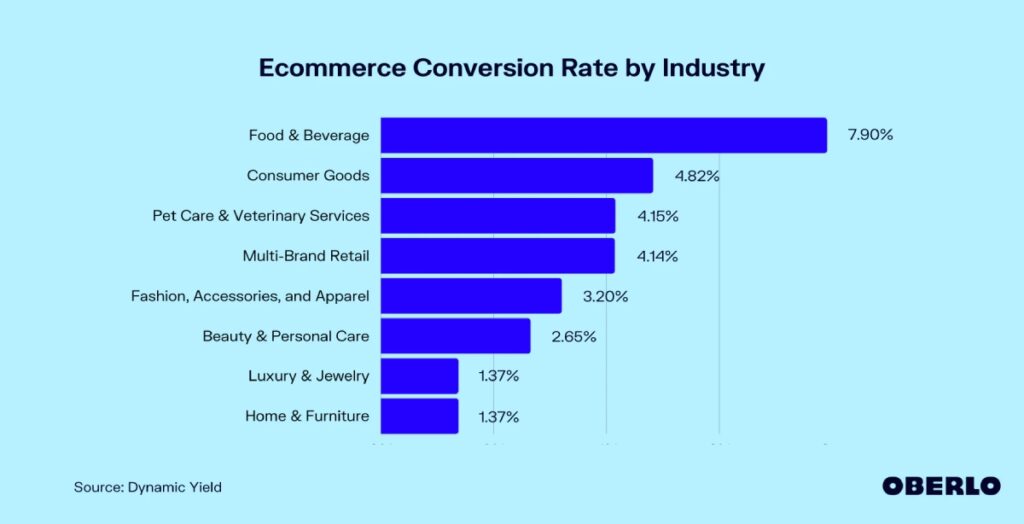
Image source: Oberlo
For SaaS companies, the priority is guiding visitors through free trials and, ultimately, paid subscriptions:

Image source: Growfusely
For lead generation sites, optimize pages involved in capturing visitor information. Lead generation sites must guide visitors to become contacts by downloading offers, requesting quotes, or submitting inquiry forms:
To summarize, continuously analyze data to identify more high-opportunity areas. Maintain testing landing pages to keep optimizing for conversions.
Implementing an effective conversion rate optimization strategy requires a structured, data-driven approach.
Follow these tips for effective optimization of your website conversion rate:
The first step is gathering data to identify areas for optimization. Analyze user behavior, surveys, page traffic, and the conversion funnel to pinpoint problems:
Analyzing how visitors navigate and interact with your site provides invaluable conversion insights. Track key user engagement metrics like clicks, scroll depth, button hovers, and page journeys to uncover usability issues, confusion, and exit points. Identify on-site struggles to inform optimization priorities.
“Your metrics influence each other. You need to monitor how. Don’t just measure which clicks generate orders. Back it up and break it down. Follow users from their very first point of contact with you to their behavior on your site and the actual transaction. You have to make the linkage all the way through.”
Lloyd Tabb, Founder, CTO at Looker
Well-designed user surveys and inquiry form analysis are essential for gathering direct feedback about the customer experience and perspective. In order to increase the form conversion rate, ask about pain points, desires, suggestions, and overall site satisfaction. Funnel insights, provided by web form conversion rate tracking, can ultimately enhance user journeys for better conversions.
Conducting traffic source analysis helps identify your highest-converting landing and product pages. Study visitor behavior flows on these high-impact pages to uncover drop-off points in the conversion process, like abandoned carts.
Visualizing the end-to-end conversion funnel with analytics reveals major bottlenecks and high abandonment areas. Assess checkout completion rates and identify steps creating friction.
With problem areas identified, you can improve website conversion optimization by optimizing conversion-critical elements:
Strategically place clear, concise, and benefit-driven calls to action across all pages to guide visitors toward desired conversions. Ensure CTAs are prominently visible through design and placement. The language should target where users are within the conversion funnel to compel action.
Minimize unnecessary steps and clicks needed to reach important pages and complete desired actions. Reduce form field to increase web form conversions, keep only essential information, provide clear next steps, and avoid clutter to minimize abandonment.
Collect user emails early in the process via lead capture forms. Then, nurture leads through targeted email campaigns. Use progress or conversion tracking on multi-page web forms. Set up smart autoresponders and workflows upon submission.
Double down on your best-performing blog posts. Ensure the content directly addresses the target audience’s questions, concerns, and objections to build trust and credibility. Optimize critical on-page elements of top posts such as headlines, preview images, layout, content structure, and calls to action for increased engagement and conversions.
An inconsistent user experience across devices can negatively impact conversions. Ensure the website is fully optimized for responsive design across all screen sizes. Check that navigation, CTAs, conversion forms, and content formatting work seamlessly on both desktop and mobile. Identify and fix mobile pain points.
Optimize form structure by simplifying fields, providing clear instructions, only requesting essential info, and ensuring mobile friendliness. Additionally, to increase form conversion rate, you can enhance the optimization process by leveraging web form tracking tools that can help identify potential issues and streamline the user experience for even higher conversion rates.
Build trust and credibility by prominently displaying social proof elements like testimonials, customer reviews, case studies, security certifications, and badges from reputable brands and institutions—feature user-generated content like ratings, videos, and images to highlight satisfaction.
Explainer and demo videos allow you to showcase the product and explain its value visually and effectively. Add videos to landing pages, listings, and campaigns. Ensure they quickly communicate benefits in a compelling way that motivates action.
With growing mobile usage, providing an optimized experience across mobile devices is vital for conversions. Avoid awkward vertical scrolling, tapping, and typing. Streamline workflows with mobile in mind—target underperforming pages and campaigns.
Leveraging personalization in your website conversion optimization efforts can be highly effective as personalized, on-site experiences boost relevance and conversions. Use data like past behaviors, clicks, purchases, demographics, and interests to tailor each visitor’s content, product recommendations, offers, and messaging.
Continuous testing and iteration are required to validate improvements as you build an effective conversion rate optimization strategy. Properly testing CRO changes confirms they deliver the expected result, avoiding guesswork. Disciplined experimentation also provides fresh data and insights to fuel further optimization. Practical testing approaches include:
A/B split testing allows you to compare a new version of a page (variation B) against the existing page (control A) to determine which version performs better. To run a valid test, only make a single focused change between versions, such as a different headline, hero image, call-to-action, or page layout.
A/B testing tools split the website’s traffic evenly between versions A, and B. Visitors are randomly shown one variation to eliminate bias. After sufficient traffic over a set time period, the tool analyzes the results, comparing conversion rates, transactions, lead captures, or other goals between variation B and control A. If variation B significantly outperforms control A, the change made will likely improve conversions.
Proper A/B testing provides data-backed validation that CRO changes like new CTAs, page copy, or layouts lift performance metrics. Testing one change at a time allows appropriate assessment of the impact of each change. A/B testing enables continuously refining page elements through ongoing experimentation to maximize conversions.

Image source: Cin7
A/B/n testing expands on standard A/B testing by comparing multiple page variations simultaneously. For example, you could simultaneously test 3 different headlines, two hero images, and two call-to-action variants on the same page.
Traffic is evenly distributed across all variations, and analytics will indicate the optimal combination that delivers the highest conversion rates. This allows testing many changes simultaneously to uncover the best-performing variation.
However, too many variations can still make it difficult to determine which specific changes had the most impact. Start with 3-5 thoughtful variations focused on key elements. Over time, continue refining through additional A/B/n tests.
Multivariate testing enables running controlled experiments on multiple elements of a page. To find the optimal page variation, you can test combinations of headline changes, body text, images, CTAs, offers, etc.
This reveals insights like how a long-form sales page performs compared to a short-form page or how video vs. image impacts conversion when combined with different headlines.
The key advantage of multivariate testing is understanding those interaction effects between page elements; this provides more insights than changing one factor at a time. However, more advanced analytics knowledge is required to configure tests effectively and analyze the complex results.
Ultimately, disciplined testing validates that conversion rate optimization changes achieve a positive impact. Continuously develop and prioritize new tests based on the latest data and insights.

Image source: Conversion Uplift
Collect relevant user data through both quantitative and qualitative sources to drive informed conversion rate optimization. Valuable data types to fuel CRO testing include:
Craft thoughtful questions to gain feedback about difficulties, desires, satisfaction, and opportunities to optimize the user experience. Offer surveys on-site or via email to collect conversion data.
Powerful analytics tools are essential for customer journey monitoring to uncover optimization opportunities. Platforms like the aforementioned Google Analytics, Adobe Experience Cloud, and Mixpanel, Amplitude, as well as specialized form tracking tools like FormStory that focus on providing in-depth analytics for website forms, crucial behavioral data on clicks, conversions, abandonment, and more.
For instance, Amplitude provides useful reports like cohort analysis to analyze groups of users over time and funnel conversion by source features to assess bottlenecks. Kissmetrics also specializes in cohort reports, which show metrics for specific groups of users based on shared traits; this reveals high-value segments. Additionally, Heap enables retroactive tracking of past user actions to capture missing data. It also automatically tracks interactions like clicks to reduce implementation work.
As for web form tracking tools, FormStory offers valuable information that identifies fields that may need improvements based on user interactions. It keeps a close watch on form abandonment rates, providing crucial insights into where users drop off and why. FormStory also offers valuable user behavior data specific to form interactions, helping businesses fine-tune their forms for maximum effectiveness and ultimately boosting form conversion rates.
For critical actions like video views, chat clicks, etc. you can implement Google Analytics event tracking. Assess reports frequently and configure customized dashboards to surface actionable insights into optimization areas. Robust analytics is foundational to an effective CRO strategy.
Implementing an effective conversion rate optimization strategy takes work but pays enormous dividends. By following the step-by-step methodology outlined in this guide, you can dramatically boost your website’s ability to turn visitors into satisfied customers. The key takeaways include:
The time to start is now. By following a rigorous, metric-driven approach to CRO, you can maximize conversion rates to amplify your business growth.